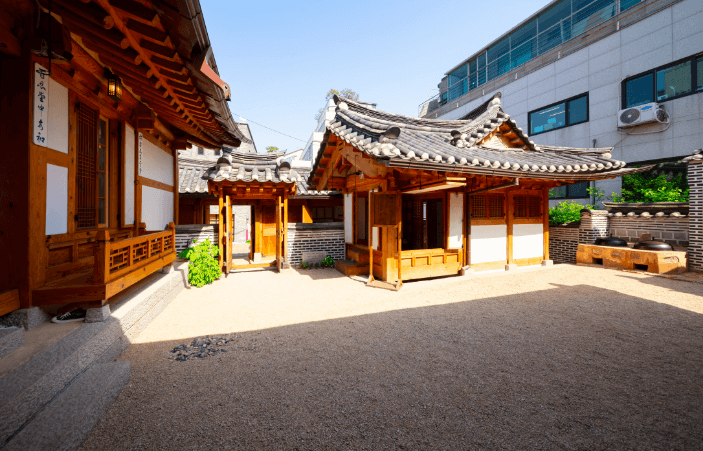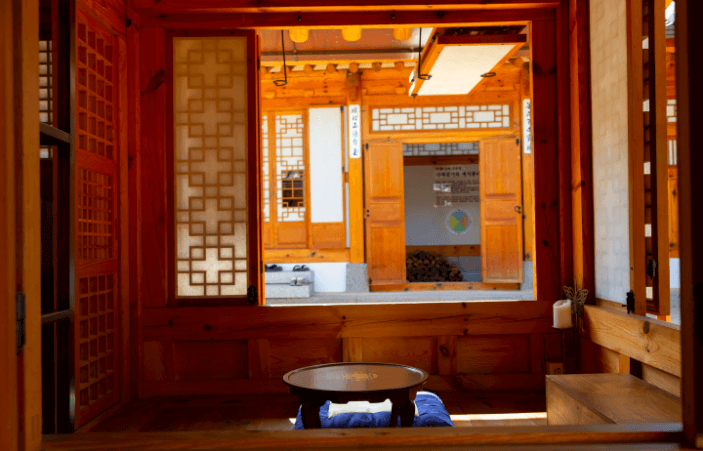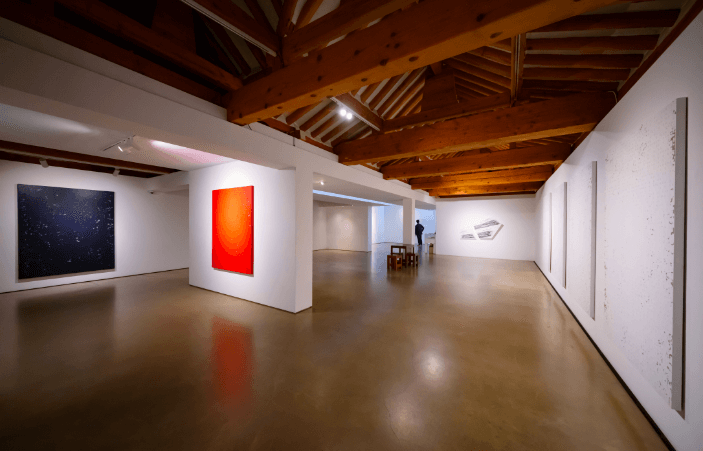Bukchon, where the past and present meet, offers a rich tapestry of culture and art. In our modern, fast-paced world, why not take a moment to pause and appreciate traditional values? Spend a day reviewing the old and learning about the new. Play traditional games in a hanok, look back on the lives of ordinary Koreans in the National Folk Museum, view art exhibits from ancient and modern eras, and participate in traditional craft workshops.
* Walking Standard

Sangchonjae is a revitalized traditional hanok cultural space left unattended for an extended time. Here, visitors can experience the daily lives and living conditions of ordinary Joseon-era citizens. The name Sangchonjae was inspired by the old name of Sejong Village, “Utdae (Sangchon),” located west of Gyeongbokgung Palace and the birthplace of King Sejong. Rather than replicating the homes of the upper class, the restored structures represent the dwellings of middle-class citizens during the Joseon period. The complex comprises three separate buildings, the main house, annex, and detached house, where visitors can appreciate the beauty and excellence of traditional Korean architecture. Inside, there is an experience zone where guests can enjoy rituals and traditional games, much like Koreans of the past.
Traditional seasonal events are held here, and we recommended checking the schedule in advance. The “Traditional Games in a Hanok” program offers a variety of fun and unique games, some of which may be unfamiliar. Take this opportunity to momentarily step back into childhood.
- Address 12-11 Jahamun-ro 17-gil, Jongno-gu, Seoul
- Inquiry 02-6013-1142
If you want to take a deeper look at the spirit and culture of Koreans, a visit to the National Folk Museum of Korea in Gyeongbokgung Palace is a must. This museum not only displays, collects and preserves Korea’s traditional living culture, but also offers a variety of activities for visitors to experience traditional life and customs. The museum consists of three exhibition halls. The first exhibits lifestyles from the prehistoric period to the Joseon Dynasty. The second hall presents detailed aspects of daily life, including professions, crafts, and ceremonies, and distinctive displays include marine life, fishing tools, and agricultural practices. The third hall presents the life journey of Koreans from birth to death, with various ceremonies and activities like watching a drama unfold. The exhibits are structured to facilitate an understanding of Korean folk culture and life, and a visit is recommended to experience the joys and sorrows of the Korean people.
- Address 37 Samcheong-ro, Jongno-gu, Seoul
- Inquiry 02-3704-3114
With the philosophy “learn from the old to create the new,” Hakgojae is a beautiful space where tradition and modernity coexist. At Hakgojae Gallery, visitors can admire a world where traditional and contemporary art come together. The main building is a traditional hanok, while the new wing features 21st-century modern architecture, which creates a harmonious blend of styles.
Traditional art pieces are highlighted with renewed value, and contemporary art pieces show traces of tradition with a modern style. Pieces by international artists are displayed alongside Korean artworks in a harmonious blend of Eastern and Western art. The gallery promises new inspirations and artistic sensibilities for all who visit.
- Address 50 Samcheong-ro, Jongno-gu, Seoul
- Inquiry 02-720-1524
Bukchon Museum, which recognizes the value of the old and includes it as a cultural heritage in our daily lives, exhibits tangible and intangible cultural assets passed down from the past. Visitors can deeply appreciate the culture embedded in these exhibits, which offer fresh interpretations and representations. The museum displays Joseon-era wooden furniture, fine arts, ceramics, and other everyday crafts, and highlights the comprehensive aura of Korean culture. The works on display vary over time, so check the exhibition themes and period on their website before visiting.
- Address 39 Bukchon-ro, Jongno-gu, Seoul
- Inquiry 02-766-8402
Have you ever admired traditional craft arts? Now, how about indulging in them with all your senses? At the Bukchon Traditional Crafts Center, visitors can listen to explanations about Korea's exquisite traditional crafts and choose one to experience firsthand. Thanks to the artisans of Bukchon, there are 40 different traditional craft programs to engage in, so participants can create a diverse range of rich artworks.
The craft activities available vary depending on the time and day, so ’”it is advisable to check the schedule of your desired craft in advance. Reservations are not necessary for individual visitors, but groups should reserve a spot over the phone at least three days in advance.
Traditional craft experiences include making petal pouches, decorative brooches, masks, emblem plaques, and lacquered hand mirrors. The programs vary by season and day, so why not visit several times to enjoy different experiences? The tradition of craft experiences passed down to this day can be enjoyed by people of all ages, and we highly recommend giving it a try.
- Address 24-5, Bukchon-ro 12-gil, Jongno-gu, Seoul
- Inquiry 02-741-2148

한국관광공사가 창작한 본 저작물은 공공누리 제4유형 조건에 따라 이용이 가능합니다.
한국관광공사에 의해 창작된 [청와대 코스 ⑦] 보통 사람들의 자취, 북촌 고유 여행은 공공라이선스에 따라 이용할 수 있습니다. 사진 자료의 경우, 피사체에 대한 명예훼손 및 인격권 침해 등 일반 정서에 반하는 용도의 사용 및 기업 CI, BI로의 이용을 금지하며, 상기 지침을 준수하지 않음으로 인해 발생하는 이용자와 제3자간 분쟁에 대해서 한국관광공사는 책임을 지지 않습니다.






















